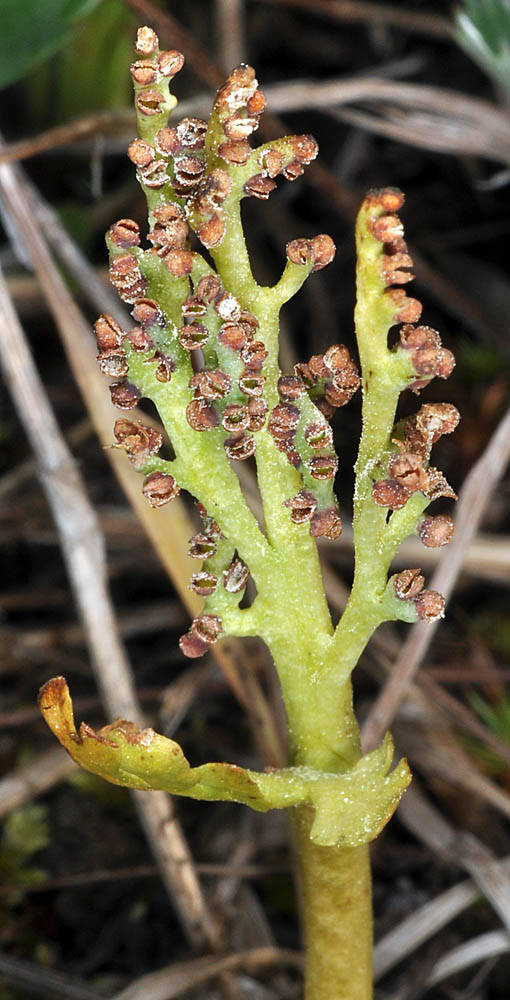
Plants 5–13(20) cm tall above ground.
Common stalks well developed, greater than 3 cm, with a prominent reddish brown stripe below trophophore.
Trophophores stalk 0.8–2.5 cm long, the stalk usually longer than distance between first and second pairs of pinnae; blade pinnate-pinnatifid, ovate-oblong to deltate-oblong, to 4.5 × 2.5 cm, dull gray-green and glaucous; pinnae ascending, approximate, the basal pinnae asymmetrically lobed, angular, broadest at or below the middle, upper pinnae becoming spatulate; pinnae lobes and apices usually acute, the margins slightly rolled; sporangia usually present on margins of basal pinnae.
Sporophores erect with stalk 0.5–1.5 times as long as the trophophore at spore release, in larger plants becoming ternately branched with lateral branches nearly as long as main axis.
Spores 36–43 μm.
2n=180 (allotetraploid, derived from B. lanceolatum and an unknown diploid).
Mesic meadows with low, herbaceous or grassy cover, gravelly soil, brushy areas, and in duff under mature Thuja plicata, at upper montane to subalpine elevations. 1200–1800 m. BW. CA, ID, WA; north to AK, northeast to MT, disjunct in Quebec. Native.
Shade-grown plants often lack marginal sporangia on the trophophore. Conversely, occasional individuals of other pinnate- pinnatifid species may possess marginal sporangia.
as described under Botrychium pedunculosum
Trophophore stalk 8--26 mm, to 1.1 times length of trophophore rachis; blade dull green, ovate-oblong to deltate-oblong, 1-pinnate, to 4.5 × 2 cm, leathery. Pinnae to 5 pairs, somewhat ascending, approximate to well separated, distance between 1st and 2d pinnae not or slightly more than between 2d and 3d pairs, basal pinna pair approximately equal in size and cutting to adjacent pair, ovate-rhombic to spatulate, lobed to tip, margin entire to irregularly lobed, apex rounded to acute, venation pinnate. Sporophores 1--3-pinnate, 2--4 times length of trophophore. 2 n =180.Leaves appearing in late spring, dying in early fall. Brushy secondary-growth habitats along streams and roadsides; of conservation concern; 300--1000 m; Alta., B.C., Sask.; Oreg.The common stalk on this species tends to be reddish brown. The presence of extra sporangia on the proximal pinnae is known only in Botrychium pedunculosum and B . ascendens .Botrychium pedunculosum grows with other moonworts, B . lanceolatum , B . lunaria , B . minganense , and B . pinnatum . It has not been found in association with the rather similar and much more common B . hesperium .